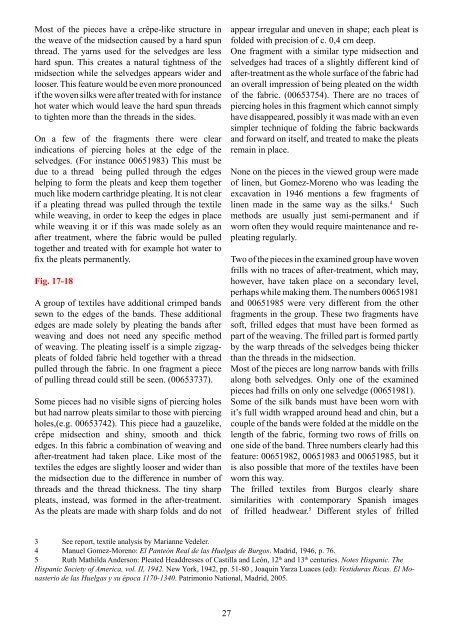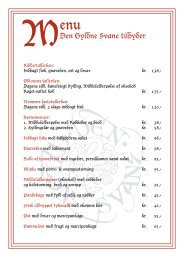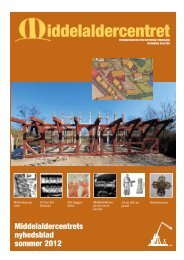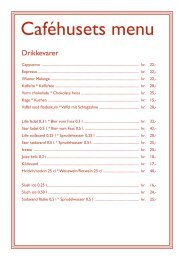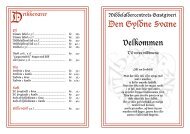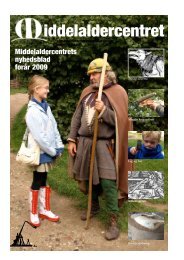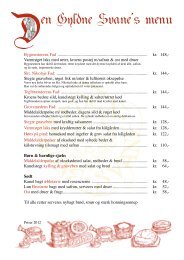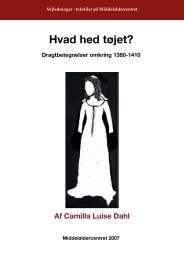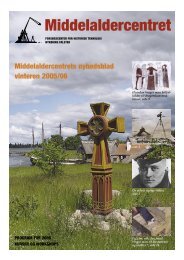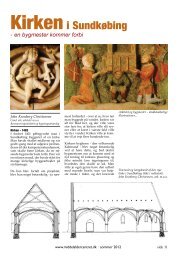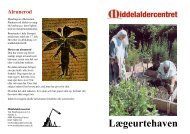Report on the Textiles from Burgos Cathedral - Middelalder Centret
Report on the Textiles from Burgos Cathedral - Middelalder Centret
Report on the Textiles from Burgos Cathedral - Middelalder Centret
Create successful ePaper yourself
Turn your PDF publications into a flip-book with our unique Google optimized e-Paper software.
Most of <strong>the</strong> pieces have a crêpe-like structure in<br />
<strong>the</strong> weave of <strong>the</strong> midsecti<strong>on</strong> caused by a hard spun<br />
thread. The yarns used for <strong>the</strong> selvedges are less<br />
hard spun. This creates a natural tightness of <strong>the</strong><br />
midsecti<strong>on</strong> while <strong>the</strong> selvedges appears wider and<br />
looser. This feature would be even more pr<strong>on</strong>ounced<br />
if <strong>the</strong> woven silks were after treated with for instance<br />
hot water which would leave <strong>the</strong> hard spun threads<br />
to tighten more than <strong>the</strong> threads in <strong>the</strong> sides.<br />
On a few of <strong>the</strong> fragments <strong>the</strong>re were clear<br />
indicati<strong>on</strong>s of piercing holes at <strong>the</strong> edge of <strong>the</strong><br />
selvedges. (For instance 00651983) This must be<br />
due to a thread being pulled through <strong>the</strong> edges<br />
helping to form <strong>the</strong> pleats and keep <strong>the</strong>m toge<strong>the</strong>r<br />
much like modern carthridge pleating. It is not clear<br />
if a pleating thread was pulled through <strong>the</strong> textile<br />
while weaving, in order to keep <strong>the</strong> edges in place<br />
while weaving it or if this was made solely as an<br />
after treatment, where <strong>the</strong> fabric would be pulled<br />
toge<strong>the</strong>r and treated with for example hot water to<br />
fix <strong>the</strong> pleats permanently.<br />
Fig. 17-18<br />
A group of textiles have additi<strong>on</strong>al crimped bands<br />
sewn to <strong>the</strong> edges of <strong>the</strong> bands. These additi<strong>on</strong>al<br />
edges are made solely by pleating <strong>the</strong> bands after<br />
weaving and does not need any specific method<br />
of weaving. The pleating isself is a simple zigzagpleats<br />
of folded fabric held toge<strong>the</strong>r with a thread<br />
pulled through <strong>the</strong> fabric. In <strong>on</strong>e fragment a piece<br />
of pulling thread could still be seen. (00653737).<br />
Some pieces had no visible signs of piercing holes<br />
but had narrow pleats similar to those with piercing<br />
holes,(e.g. 00653742). This piece had a gauzelike,<br />
crêpe midsecti<strong>on</strong> and shiny, smooth and thick<br />
edges. In this fabric a combinati<strong>on</strong> of weaving and<br />
after-treatment had taken place. Like most of <strong>the</strong><br />
textiles <strong>the</strong> edges are slightly looser and wider than<br />
<strong>the</strong> midsecti<strong>on</strong> due to <strong>the</strong> difference in number of<br />
threads and <strong>the</strong> thread thickness. The tiny sharp<br />
pleats, instead, was formed in <strong>the</strong> after-treatment.<br />
As <strong>the</strong> pleats are made with sharp folds and do not<br />
27<br />
appear irregular and uneven in shape; each pleat is<br />
folded with precisi<strong>on</strong> of c. 0,4 cm deep.<br />
One fragment with a similar type midsecti<strong>on</strong> and<br />
selvedges had traces of a slightly different kind of<br />
after-treatment as <strong>the</strong> whole surface of <strong>the</strong> fabric had<br />
an overall impressi<strong>on</strong> of being pleated <strong>on</strong> <strong>the</strong> width<br />
of <strong>the</strong> fabric. (00653754). There are no traces of<br />
piercing holes in this fragment which cannot simply<br />
have disappeared, possibly it was made with an even<br />
simpler technique of folding <strong>the</strong> fabric backwards<br />
and forward <strong>on</strong> itself, and treated to make <strong>the</strong> pleats<br />
remain in place.<br />
N<strong>on</strong>e <strong>on</strong> <strong>the</strong> pieces in <strong>the</strong> viewed group were made<br />
of linen, but Gomez-Moreno who was leading <strong>the</strong><br />
excavati<strong>on</strong> in 1946 menti<strong>on</strong>s a few fragments of<br />
linen made in <strong>the</strong> same way as <strong>the</strong> silks. 4 Such<br />
methods are usually just semi-permanent and if<br />
worn often <strong>the</strong>y would require maintenance and repleating<br />
regularly.<br />
Two of <strong>the</strong> pieces in <strong>the</strong> examined group have woven<br />
frills with no traces of after-treatment, which may,<br />
however, have taken place <strong>on</strong> a sec<strong>on</strong>dary level,<br />
perhaps while making <strong>the</strong>m. The numbers 00651981<br />
and 00651985 were very different <strong>from</strong> <strong>the</strong> o<strong>the</strong>r<br />
fragments in <strong>the</strong> group. These two fragments have<br />
soft, frilled edges that must have been formed as<br />
part of <strong>the</strong> weaving. The frilled part is formed partly<br />
by <strong>the</strong> warp threads of <strong>the</strong> selvedges being thicker<br />
than <strong>the</strong> threads in <strong>the</strong> midsecti<strong>on</strong>.<br />
Most of <strong>the</strong> pieces are l<strong>on</strong>g narrow bands with frills<br />
al<strong>on</strong>g both selvedges. Only <strong>on</strong>e of <strong>the</strong> examined<br />
pieces had frills <strong>on</strong> <strong>on</strong>ly <strong>on</strong>e selvedge (00651981).<br />
Some of <strong>the</strong> silk bands must have been worn with<br />
it’s full width wrapped around head and chin, but a<br />
couple of <strong>the</strong> bands were folded at <strong>the</strong> middle <strong>on</strong> <strong>the</strong><br />
length of <strong>the</strong> fabric, forming two rows of frills <strong>on</strong><br />
<strong>on</strong>e side of <strong>the</strong> band. Three numbers clearly had this<br />
feature: 00651982, 00651983 and 00651985, but it<br />
is also possible that more of <strong>the</strong> textiles have been<br />
worn this way.<br />
The frilled textiles <strong>from</strong> <strong>Burgos</strong> clearly share<br />
similarities with c<strong>on</strong>temporary Spanish images<br />
of frilled headwear. 5 Different styles of frilled<br />
3 See report, textile analysis by Marianne Vedeler.<br />
4 Manuel Gomez-Moreno: El Panteón Real de las Huelgas de <strong>Burgos</strong>. Madrid, 1946, p. 76.<br />
5 Ruth Mathilda Anders<strong>on</strong>: Pleated Headdresses of Castilla and León, 12 th and 13 th centuries. Notes Hispanic. The<br />
Hispanic Society of America, vol. II, 1942. New York, 1942, pp. 51-80 , Joaquin Yarza Luaces (ed): Vestiduras Ricas. El M<strong>on</strong>asterio<br />
de las Huelgas y su época 1170-1340. Patrim<strong>on</strong>io Nati<strong>on</strong>al, Madrid, 2005.


